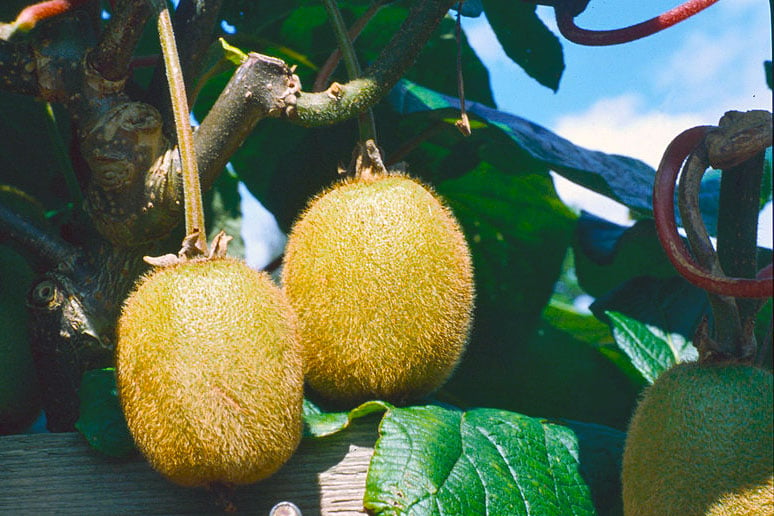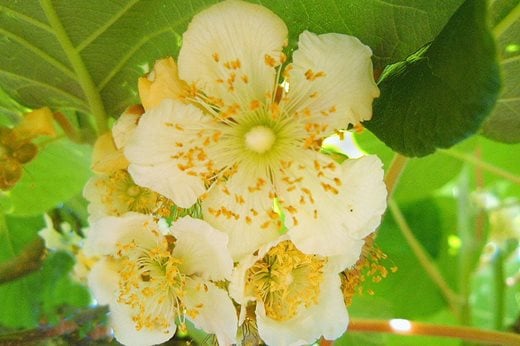 Botanical name: Actinidia deliciosa
Origins:
Botanical name: Actinidia deliciosa
Origins: Kiwi fruit are native to China, where they can still be found growing in the wild.
First cultivated: Rarely cultivated in its native China, commercial plantings of kiwi fruit didn’t occur until the 20th century in New Zealand.
Types: Popular varieties that grow well in the UK include ‘Hayward’ (female), ‘Atlas’ (male) and
‘Jenny’ (self-fertile).
RHS advice: How to grow kiwi fruit.
Did you know?
Actinidia deliciosa, the plant that produces what we now know as kiwi fruit, started its life in the wild, growing abundantly in northern and eastern China many hundreds of years ago. The first recorded description of it dates back to the 12th century during the Song dynasty. Collected from the wild and consumed predominantly for medicinal purposes, the kiwi fruit was rarely cultivated in its native China where it was known as
yang tao meaning ‘strawberry peach’.
Specimens of the plant were collected in 1847 by the agent for the Royal Horticultural Society, and in 1900, seeds were sent by the notable plant collector, E.H. Wilson to the English nursery firm, James Veitch & Sons Ltd. However, the seeds only produced male plants, scuppering the growers’ plans to produce the edible fruit, then known as the Chinese gooseberry.
Meanwhile, growers on the other side of the world were having more success. In 1904 in New Zealand, Mary Isabel Fraser, the principal of an all-girls school, brought back some Chinese gooseberry seeds from China. She gave them to a farmer named Alexander Allison who planted them at his farm near Whanganui, and the vines went on to bear their first fruit in 1910.
By 1940, many New Zealand growers were cultivating the plants, particularly along the eastern coast of the North Island. The fruit proved very popular with American and British servicemen stationed in New Zealand during World War II and by the 1950s, Chinese gooseberries were being exported to the UK and USA.
However, at the height of the Cold War, the name ‘Chinese gooseberry’ was proving to be a marketing nightmare, as well as being misleading (gooseberries are from a different botanical family altogether.) The fruit was briefly re-named ‘melonette’ before being re-branded in 1959 as ‘kiwi fruit’, after the furry, brown, flightless national bird of New Zealand to which it was thought to bear a resemblance. The moniker stuck, the popularity of the fruit began to soar, and kiwi fruit became one of New Zealand’s defining agricultural products, generating over NZ$1 billion in export revenue by 2015.
Packed full of health-boosting antioxidants, kiwi fruit contain almost twice as much vitamin C as an orange. They’re also rich in vitamin K, which can help prevent heart disease, and vitamin E, which supports the immune system and helps maintain healthy eyes and skin. Eaten fresh as a fruit, blended into a smoothie, or preserved as a jam, there are plenty of ways to include this beneficial fruit in your diet.

Once deemed exotic, there are many varieties of kiwi fruit that grow well in the UK, so long as you plant them in a sunny, sheltered position using rich, well-drained, slightly acidic soil.
RHS advice: how to grow kiwi fruit
Vigorous climbers, they can be trained up trellises and over arches. The delicate yellow flowers and lush foliage make them perfect ornamentals, but self-fertile varieties such as
‘Jenny’ will reward you with a bumper crop of juicy fruit after about three years.
Striking to look at, packed with nutritional benefits and with a deliciously unique flavour, kiwi fruit offer a taste of the Orient, and can now be successfully grown at home.

